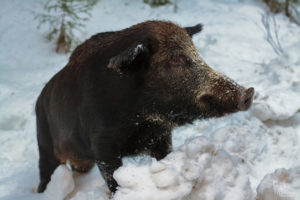Feral hogs are an invasive species introduced to North America in the 1500s by European explorers. They can now be found throughout the southeastern Unites States and often have negative economic and environmental effects in the areas where they occur. For this reason, hog populations need to be managed throughout their nonnative range. When developing management plans for invasive species, it is important to understand the ecology of the animal to ensure that the most effective management strategies are implemented.
Habitat

In their native range, wild boar regularly occupy colder climates with annual snowfall. Photo courtesy of Svetlana Kholodnyak.
Feral hogs are very adaptable animals that are able to thrive in a variety of ecosystems. They are considered habitat generalists which means that they can successfully occupy a variety of habitats with different temperatures, rainfall amounts, elevations, and vegetation types. Generally speaking, the factors that limit the range of feral hogs are access to food and access to water. Habitat selection can vary from one season to the next based on the availability of those resources. This flexibility has enabled feral hogs to expand their range as their populations grow.
Diet
Feral hogs are opportunistic omnivores. The majority of their diet is made up of plant matter and while the specific composition changes based on season and location, the plants consumed often include acorns and underground roots, tubers, and bulbs. Feral hogs use their snout to dig into the ground or “root” through an area overturning loose soil to access subterranean resources. Rooting is a highly effective foraging strategy, but can greatly impact the habitats it occurs in. As omnivores, feral hogs also consume animal matter. Even though it makes up a much smaller portion of their overall diet, animal matter consumed by hogs can include birds, mammals, reptiles, carrion, and often earth worms. Feral hogs tend to concentrate on abundant natural food sources such as a crop of acorns, or on similarly abundant non-natural food sources such as agricultural crops. Knowing when and where abundant food sources occur can help with strategizing how management techniques will be implemented.
Water
Access to water can be a limiting factor for feral hogs because they are very poor thermoregulators. Feral hogs do not possess sweat glands which means they must rely on other strategies to regulate their temperature and stay cool. In warmer conditions feral hogs can use shaded areas, feed nocturnally, or wallow in mud to maintain appropriate temperatures. Wallowing can occur in natural bodies of water which can have negative environmental impacts, or in man-made bodies of water which can cause health related risks to humans and domestic animals due to the diseases associated with feral hogs.
Reproduction and Social Behaviors
The feral hogs seen today are descendants of domestic swine who were intentionally bred to reproduce quickly, often, and in large quantities. Male feral hogs can begin reproducing at 12 to 18 months old. Males are typically solitary individuals who can be territorial and will fight for the opportunity to breed. Female feral hogs can begin reproducing as early as 6 to 12 months old. Gestation only takes 115 days, and each litter contains 4 to 6 piglets on average. Females are more social animals and typically travel in multi-generational groups of related individuals called sounders. These groups can range from 2 individuals up to 50 individuals and allow the hogs to better protect their offspring from potential predators.
The Perfect Invader
The combination of being habitat generalists, having an omnivorous diet, and being highly reproductive has made feral hogs a very successful invasive species in many places around the world. Due to competition with native animals, their destructive foraging techniques, and use of water sources for wallowing, feral hogs often have a negative impact on the habitats they occupy. Additionally, they cause millions of dollars in damage to agricultural operations and pose serious health related threats where their range overlaps with domestic animals and humans. Understanding the ecology of this species can help managers to be more successful as they try to reduce the impacts made by feral hogs.


